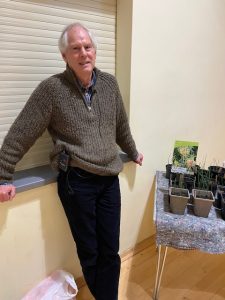A talk given by Andrew Sankey on Sir William Hooker
Saturday 18th Nov. 2pm
Bawdeswell Village Hall, Reepham Road NR20 4RU

Andrew Sankey gave us a very entertaining and lively talk about William Hooker. He was born in Norwich in 1785. He was educated at Norwich Grammar School and was a clever boy. Fascinated by botany from a very early age, he became friends with Dawson Turner, and they used to go on nature trips together. Dawson Turner was a renowned naturist and a banker, head of the Gurney-Turner bank.
Hooker was made the manager of a brewery in Halesworth. He lived in the brewery house where he grew orchids. He spent the majority of his time botanising rather than running the brewery which suffered. Hooker discovered a rare moss and was elected a fellow of the Linnaen Society. There he met Sir Joseph Banks who was to be a great influence. Banks enjoyed putting people together, and he persuaded Hooker to travel. Hooker inherited some money which enabled him to do so, and Banks sent him to Iceland on a collecting trip. Sadly fire broke out on the ship on the way home and little survived. Hooker married Dawson Banks daughter Maria. He went to Europe for nine months to study plants, and met some of the leading botanists there.
In 1820 Hooker left the brewery, which wasn’t doing well, and went to Glasgow to be Regius Professor of Botany at Glasgow University. He also took over Glasgows 8 acre botanic gardens. Banks sent plants for the gardens up from Kew. Hooker was an inspiration to young people and helped them learn and develop their skills. He published many journals and articles and was a pioneer in the study of economic botany. He held the position at the University until 1841.
He was appointed the first Director of Kew Gardens. Under his leadership Kew Gardens became one of the world’s leading botanical institutions. Since the death of Banks and George lll Kew had been going downhill. It was eventually saved by Queen Victoria. When Hooker moved to Kew it took five ships to bring his library and herbarium to London. He reorganised the whole garden and commissioned a glasshouse to be called the Palm House. It was based on a design at Chatsworth by Decimus Burton and Richard Turner. He extended gravel pits at Kew and flooded them for wildlife. It is the only botanic garden to have it’s own police force.
In 1855 a succulent house was added. Kew went on to become a vast complex including laboratories, a museum, a library and greenhouses. His son Joseph Hooker took over the running of Kew having travelled widely. He was a friend of Charles Darwin.
The Temperate House was William Hookers last achievement also designed by Decimus Burton and Richard Turner. He died in 1865 aged 81.
